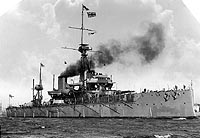Navy!

This is coolbert:
Well, navies throughout the world are certainly not what they were 100 years or so ago.
Navies have become somewhat of an anachronism.
It used to be that all world powers and aspiring world powers had a large pelagic [deep water] navy.
A navy that would show the colors all over the world.
Project power.
Especially in the hey-day of the colonial powers.
Britain, U.S., France, Germany, Russia, Japan, all had large navies 100 years ago.
And in the day of the wind powered sailing men-of-war, Spain, Holland, and Portugal could at one time put large navies on the oceans of the world.
In the years prior to WW2, Italy made the decision to build and deploy a significant naval force in the Mediterranean as part of it's nationalist/imperialist agenda.
Navies counted their ability to fight in the number of capital ships they could deploy. Capital ships [battleships] were the means by which navies were to fight future [I am speaking here of the year 1900] battles at sea.
A countries technological expertise was measured by it's ability to produce the largest capital ship with the largest guns [prior to the building of the Space Shuttle, the Iowa class battleship was the most complicated thing made by man].
An entire panoply of supporting vessels was created to support the capital ships.
Navies counted their ability to fight in the number of capital ships they could deploy. Capital ships [battleships] were the means by which navies were to fight future [I am speaking here of the year 1900] battles at sea.
A countries technological expertise was measured by it's ability to produce the largest capital ship with the largest guns [prior to the building of the Space Shuttle, the Iowa class battleship was the most complicated thing made by man].
An entire panoply of supporting vessels was created to support the capital ships.
Cruisers of all types, heavy, armored, light, fast, all existed.
Destroyers, torpedo boats, submarines, and later, aircraft carriers all were created [the original concept of the aircraft carrier was AS A SUPPORT VESSEL to the battleships, and adjunct to the main force of the navy, the capital ships.
To supply the coal fired boilers of the navies, strategically located coaling stations all over the world were desired and obtained by the major powers. Colliers [ships carrying coal] were constantly in position on the oceans of the world to meet the insatiable demand for coal to fire the coal fire boilers of the dreadnoughts.
And these large navies and deployments of capital ships made for dramatic photography too. Seeing five battleships sailing in line, tremendous quantities of thick black smoke trailing behind them, is a very impressive sight. Well, that was the intention, was it not, to impress??
This has almost all become a thing of the past.
With the exception of the United States, no one else is able to put to sea a large navy to fight wars and project power. The other last super-power, the Soviet Union, now has a large fleet laying at anchor, or slowing sinking in harbors all over Russia.
And in very rare instances, such as the Falkland Islands War, the British did successfully deploy their navy, but with great difficulty. This was not a sustainable venture on the part of the British.
And what are the reasons for navies disappearing all over the world?
Technology for one thing. Aircraft and missile technology has rendered surface ships very vulnerable.
The former colonial powers, Britain, France, etc., no longer possess their colonies throughout the world, another reason for having a large navy being obviated.
And cost is a major concern. Modern ships are just expensive. Just to build a state-of-the-art destroyer costs about $1 billion dollars. Most countries cannot afford this expense.
Navies still do exist, but mostly now in a coastal defense role, or in what would be termed "coast guard" activity in the U.S.
coolbert.
To supply the coal fired boilers of the navies, strategically located coaling stations all over the world were desired and obtained by the major powers. Colliers [ships carrying coal] were constantly in position on the oceans of the world to meet the insatiable demand for coal to fire the coal fire boilers of the dreadnoughts.
And these large navies and deployments of capital ships made for dramatic photography too. Seeing five battleships sailing in line, tremendous quantities of thick black smoke trailing behind them, is a very impressive sight. Well, that was the intention, was it not, to impress??
This has almost all become a thing of the past.
With the exception of the United States, no one else is able to put to sea a large navy to fight wars and project power. The other last super-power, the Soviet Union, now has a large fleet laying at anchor, or slowing sinking in harbors all over Russia.
And in very rare instances, such as the Falkland Islands War, the British did successfully deploy their navy, but with great difficulty. This was not a sustainable venture on the part of the British.
And what are the reasons for navies disappearing all over the world?
Technology for one thing. Aircraft and missile technology has rendered surface ships very vulnerable.
The former colonial powers, Britain, France, etc., no longer possess their colonies throughout the world, another reason for having a large navy being obviated.
And cost is a major concern. Modern ships are just expensive. Just to build a state-of-the-art destroyer costs about $1 billion dollars. Most countries cannot afford this expense.
Navies still do exist, but mostly now in a coastal defense role, or in what would be termed "coast guard" activity in the U.S.
coolbert.
Labels: Naval

<< Home